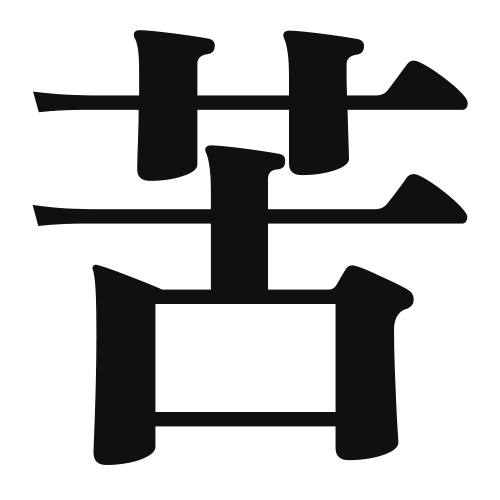1. Overview of Meaning
The kanji “苦” (ku) primarily means “suffering” or “pain.” It conveys a sense of hardship, distress, or discomfort, often associated with emotional or physical challenges.
2. Formation and Radical
Formation of the Kanji: The kanji “苦” is a compound character (会意文字) that combines elements to convey its meaning. It consists of the radical for “grass” (艹) at the top, which often relates to plants or nature, and the character “古” (ko) at the bottom, which means “old.” This combination suggests the idea of something old and unpleasant, like bitter herbs.
Radical: The radical for “苦” is 艹 (grass), indicating its connection to nature and plants.
3. Examples of Usage
Common Words and Phrases: Some frequently used words that include “苦” are:
- 苦痛 (くつう, kutsuu) – pain, suffering
- 苦しい (くるしい, kurushii) – painful, difficult
- 苦労 (くろう, kurou) – hardship, trouble
Example Sentences in Daily Conversation:
- 最近、仕事がとても苦しいです。 (Saikin, shigoto ga totemo kurushii desu.) – Recently, work has been very painful for me.
- 彼は苦労して成功を収めました。 (Kare wa kurou shite seikou o osamemashita.) – He achieved success through hardship.
4. Synonyms and Antonyms
Similar Kanji: A kanji with a similar meaning is “痛” (itami), which means “pain” but is more focused on physical pain rather than emotional suffering.
Opposite Kanji: An antonym is “楽” (raku), which means “comfort” or “ease,” representing a state free from suffering or pain.
5. Cultural and Historical Background
Connection to Japanese Culture: The concept of “苦” is deeply rooted in Japanese culture, often reflected in literature, art, and philosophy. It is associated with the Buddhist idea of suffering and the path to enlightenment.
Proverbs and Idioms: One common proverb is “苦あれば楽あり” (ku areba raku ari), which translates to “where there is suffering, there is also joy,” emphasizing the balance of life’s experiences.
